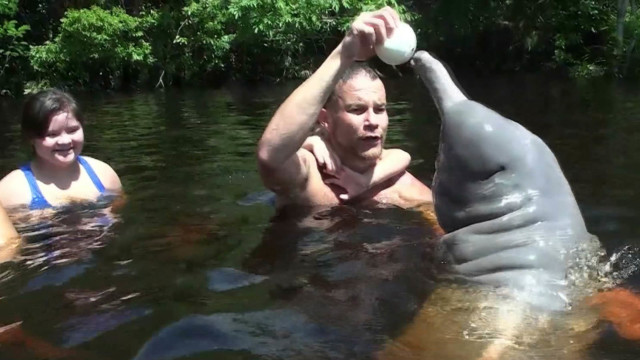In Brazil, a physio-therapist is turning to dolphins to help the disabled. He’s using the Amazon River Dolphins, also called the boto, in a therapy program for special needs children and adults.
CGTN’s Paulo Cabral traveled to the Negro River to see the botos in action.
Leo Cavalcanti is a regular 19 year old teenager who just happened to be born with no arms. But when he drives his car, he shows he’s managed to overcome many of the limitations of his disability, and for that, he credits the unlikely help of Amazon pink dolphins. Leo was eight when he began participating in boto-therapy sessions, which were created some 12 years ago by physiotherapist Igor Simoes here in the Brazilian Amazon.
“Boto therapy is a method to interact with the Amazon River Dolphins in the wild,” Simoes said. “This work requires research on animal behavior and on how to manage the boto and integrate it into physiotherapy sessions. In other places, therapy using animals is done with horses and with dogs. Here we use the river dolphins.”
“I can say with all honesty that the dolphins helped me a lot,” Leo said. “They helped me to have better balance and better breathing. And this therapy also helped me to express myself.”
Ten-year-old Glenda has cerebral palsy and has taken a few sessions over the last couple of years. Her mother sees much benefit.
“Every time the children come here we can clearly see the difference this makes to them,” Jessica Neves, Glenda’s mother said. “Even the way they behave at home changes over time. Glenda is a good example–she was very stressed all the time and the therapy helped her with that. She also overcame her fear of animals, which is very common among special needs children.”
Tourists also come to swim with the botos. They are not allowed as much interaction as the therapy groups but still get in the water and are allowed to get very close to the animals.
These pink dolphins are beautiful animals and also very friendly, particularly here as they are used to people coming to visit. But being so close to civilization also brings problems. These animals are endangered.
“It’s a species that is considered endangered because of the pressure of the development projects and also more recently because of direct hunting,” said Vera da Silva of the National Research Institute of the Amazon in Brazil. “About two decades ago the local fisherman started to kill dolphins to use as bait to catch catfish, that were almost all exported to Colombia.”
Simoes said the dolphins’ powerful sonar also has a healing effect on humans, a claim the medical community does not endorse. But the clear benefits the children report just in connecting with another species seem enough to keep bringing them back to the botos.
 CGTN America
CGTN America

